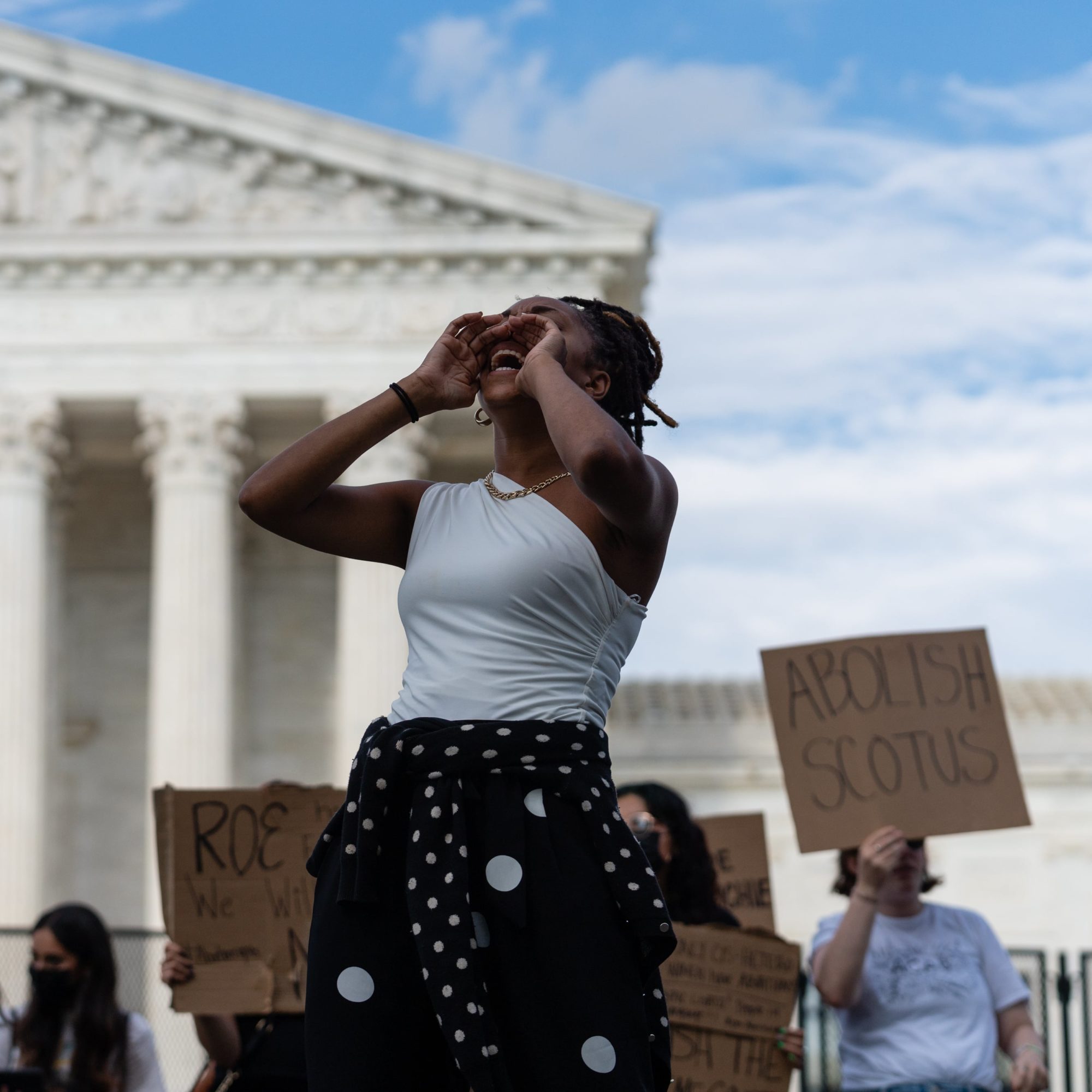
- POPSUGAR Australia
- Fitness
- Will Roe Ever Be Law Again? Here’s How History Could Inform the Future.
Will Roe Ever Be Law Again? Here’s How History Could Inform the Future.

This article is part of POPSUGAR’s project Roe, 50 Years Later, a collection of stories marking what would have been the 50th anniversary of Roe v. Wade. This moment comes more than six months after the Supreme Court struck down the constitutional right to an abortion in Dobbs v. Jackson Women’s Health Organization, and these stories seek to mark the past, present, and future of abortion access in America.
Sarah Weddington was 26 – just a few years out of law school, without a single court case under her belt – when she stood in front of the Supreme Court in 1971 and enumerated some of the consequences of pregnancy.
“It disrupts her body, it disrupts her education, it disrupts her employment, and it often disrupts her entire family life,” she said, addressing the all-male justices (one of whom told President Richard Nixon he’d resign before he’d let him appoint a female justice) in her arguments on behalf of Norma McCorvey – or for the purposes of this case, Jane Roe.
Weddington didn’t share that when she got pregnant during her last year of law school, she drove to Mexico and got an abortion through a door in an unmarked alley rather than risk derailing her life. She didn’t experience complications, but, as she’d later write in Texas Monthly, she knew many of her contemporaries had chosen more desperate paths, including throwing themselves down a staircase or drinking cleaning products.
Despite Weddington’s inexperience, the Supreme Court ruled in her favor in 1973, finding that the 14th Amendment’s Due Process Clause conferred a right to privacy that protected the right to an abortion until a fetus is viable outside the womb.
“The Roe that they invented was way better than the Roe that actually existed.”
When Roe was overturned in Dobbs v. Jackson Women’s Health Organization last year – just six months after Weddington died at the age of 76 – it was a gutting decision for abortion-rights advocates. But many activists and legal scholars say it was also a chance to reevaluate an imperfect legal case with even less-perfect real-world ramifications.
“Roe became a symbol that a lot of people projected things onto that the Supreme Court never said,” says Mary Ziegler, a legal scholar and author of the forthcoming book “Roe: The History of a National Obsession,” pointing out that popular phrases like “a woman’s right to choose” were never what the Supreme Court delivered. “The Roe that they invented was way better than the Roe that actually existed.”
For abortion-rights advocates, contemplating the future of the procedure doesn’t mean trying to get Roe back; it means reimagining what stronger legal protections could look like – and perhaps more importantly, remembering that courts are only one avenue to gaining rights.
“Now is a good moment for the reproductive-rights movement to take stock of what went wrong the first time and how to change it,” Boston University law professor Aziza Ahmed says.
The Problem With Roe
Even among proponents of abortion access, the majority opinion on Roe, authored by Justice Harry Andrew Blackmun, was controversial. Once it became the law of the land, lawyers, including Justice Ruth Bader Ginsburg, argued that Roe should have conferred rights upon people to get an abortion, rather than just onto doctors to provide them. Another common critique of Roe was that the 14th Amendment was shaky ground because the Constitution only intimates privacy and never explicitly states it. The Equal Protection Clause, many have argued, would have provided a stronger basis given that a lack of abortion access disproportionately impacts women.
As conservatives geared up for a decades-long assault on the case, it didn’t take long for Roe to spring leaks. In 1976, the Hyde Amendment prohibited the use of federal funds for most abortions, which meant Medicaid users could no longer get an abortion covered. In 1980, the Supreme Court upheld the law in Harris v. McRae, creating what some feminist legal scholars have called a two-tiered system for abortions: access for those with money and denial for those without.
The rules only got more restrictive with time. In 1982, Pennsylvania instituted a slew of barriers to an abortion – including a waiting period, as well as mandating that minors get consent from their parents and that married women notify their spouses of their plans to get an abortion.
When challenges to these provisions made it to the Supreme Court in Planned Parenthood v. Casey in 1992, many thought it would be Roe’s death knell. Instead, it was another dent in Roe’s armor, overturning its “strict scrutiny” standard (the court’s highest level) in favor of a more legally vulnerable “undue burden” standard – which allowed most of Pennsylvania’s restrictions to stand.
“Roe was critical in that it legalized abortion, but it always set up this path in which you have to abide by certain rules in order to be able to get an abortion,” abortion-rights activist Renee Bracey Sherman says. Crucially, these rules fell disproportionately on low-income women, women of color, and women in rural areas.
Bracey Sherman adds that while Roe might have legalized abortion in some cases, it didn’t decriminalize it. Research by the reproductive-rights legal organization If/When/How found that between 2000 and 2020, there were 61 cases of people criminally investigated or arrested on the suspicion that they had tried to end their own pregnancy or helped someone else do so.
How the Political Context Shaped Roe
Weddington’s case might have been the one that got abortion on the books, but it came amid a slew of similar legal challenges. This included the 1971 case known as Women v. Connecticut, in which law student Ann Hill organized more than 2,000 women through her women’s liberation group to sue the state over its law restricting abortion in a class-action lawsuit after her own illegal abortion. Another was 1973’s Doe v. Bolton, a case challenging Georgia’s abortion law that was in front of the court at the same time as Roe.
“When Roe happened, it didn’t happen in a vacuum.”
The preceding decades also saw the liberal Supreme Court desegregate schools, ban prayer in schools, and outline the right to contraception and interracial marriage. And these legal challenges weren’t happening in isolation. The civil rights movement, the antiwar movement, and the feminist movement built a culture of grassroots organizing, lobbying, protests, state legislative efforts, and civil disobedience – all of which laid the groundwork for Roe’s passage.
“When Roe happened, it didn’t happen in a vacuum. Courts are in dialogue with movements and politicians and other actors who have thoughts on the Constitution,” Ziegler says, emphasizing the falsehood of some justices’ claims of immunity to political pressure or cultural shifts. “We talk about it as if the Supreme Court gave us abortion rights and took abortion rights away, when if you dig into the history, it’s much more complicated than that.”
Ahmed says students in her reproductive-rights course often don’t connect protest or direct action with legal decisions on abortion, suggesting a fault in the contemporary reproductive-rights movement.
“Some of the most powerful moments in the history of the feminist women’s health movement [are] when women really took things into their own hands and forced the world to really acknowledge them,” Ahmed adds.
What’s the Future of Abortion and the Supreme Court?
While the current conservative makeup of the Supreme Court means the cards are stacked against constitutional protections, Ahmed says it is important to try anyway – even failed legal cases can set precedents for future successes, a strategy that antiabortion activists used to undo Roe.
“To ensure that people get the abortions that they need, some people are just gonna have to ignore the line of legality and illegality.”
Legal battles could look like last year’s failed attempts by Democratic Congress members to pass the Women’s Health Protection Act, which would federally protect a person’s right to end a pregnancy. And many legal scholars point to the 14th Amendment’s Congressional Enforcement Clause – which could be used to stop states from depriving people of “life, liberty, or property” – as a possible avenue for legal protections for abortion.
Ahmed and Ziegler both say the law must continue to be considered a critical tool in securing abortion rights, but it can’t be the only one.
“It feels as if the court is the be-all-end-all, but the longer course of history suggests the opposite – and it suggests that when people believe that, it actually hurts their organizing,” Ziegler says of the Supreme Court’s decision on Roe. She adds that an overemphasis on the courts as the avenue for reproductive justice is part of a “professionalization” of some parts of the movement, which has at times focused more on things like court cases, polling, and focus groups than on mobilizing, organizing, and service provision, often to the detriment of abortion access.
“The way people relied on litigation, it was like people were forgetting what they were capable of doing,” she says.
Bracey Sherman agrees that the law should be one tool in the movement’s toolbox – but also that as laws evolve around things like abortion-pill distribution and self-managed abortions, they might need to be disregarded.
As she puts it: “To ensure that people get the abortions that they need, some people are just gonna have to ignore the line of legality and illegality – because my belief is that it’s an unjust line.”


